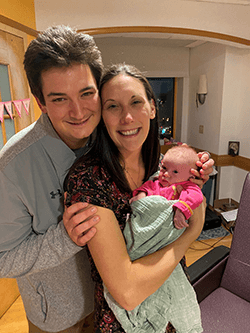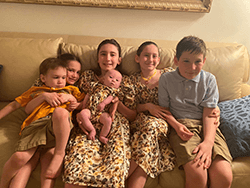On October 1st, 2021, Laura and Pete Bianco of Pittsburgh’s South Hills, welcomed their daughter Felicity into the world. Having been through the delivery process with their five older children, they knew what to expect. But Felicity’s birth was different.
“Of my six pregnancies, Felicity’s was the easiest. Each of her siblings had come on time or late. She was two and a half weeks early,” says Laura.
“I had a sense for what a newborn with Down syndrome might look like. When she was first born, I could see her unique features and it was clear to me that she was special,” adds Pete.
Children born with Down syndrome often have certain characteristics such as almond shaped eyes, a flat nasal bridge, or space between their toes. Shortly after Felicity was born, a pediatrician told the new parents that she showed common markers for Down syndrome.
“It sucked the air out of the room. You don’t know how you’ll react in that moment,” says Pete. “Our immediate reaction was concern for our daughter. We didn’t know what this meant…What will her future look like? Will she play with toys, with her siblings?”
The pediatrician then took Felicity out of the room for additional blood tests to confirm the diagnosis.
While her blood was being drawn, Felicity went into respiratory distress, and her oxygen levels fell dangerously low as she fought for air. The delivery team told the Biancos that their daughter would need to be transported to UPMC Children’s Hospital of Pittsburgh, a facility where they could more adequately receive the quality of care Felicity needed.
A UPMC Children’s emergency transfer team was called in to transport Felicity.
“At this point, we had so little exposure to Down syndrome. We learned very quickly that there are other health complications involved. We were getting this new information piled on with the diagnosis. It was scary,” says Laura.
Children born with Down syndrome can be born with additional health conditions such as heart defects, gastrointestinal (GI) issues, or problems with vision and hearing.
Transferred to UPMC Children's
The Biancos’ first feeling of relief came when the transfer team arrived.
“Learning that we couldn’t travel with her in the ambulance was crushing. But when the transfer team came in, that was our first exposure to Children’s. They gave every step that they would take and explained everything that they were doing to ensure her safety,” says Laura.
 Greg Barretto, MD, a member of the UPMC Newborn Medicine Program, met the Biancos in Felicity’s room in the Neonatal Intensive Care Unit (NICU).
Greg Barretto, MD, a member of the UPMC Newborn Medicine Program, met the Biancos in Felicity’s room in the Neonatal Intensive Care Unit (NICU).
“He was the first person that was able to sit and talk in detail with us, asking what questions we had. We sat for a while and started to ask all those initial questions,” says Pete. “At that point we didn’t know anything. Dr. Barretto provided excellent insight into what Felicity’s future may look like as a person with Down syndrome, mentioning that it would not be unrealistic to think she could attend college or get married if she chose to do so.”
Dr. Barretto explained that every person is different, but Felicity would be able to do what any other child could do.
A few days later, doctors discovered that Felicity had a duodenal web, a partial blockage in her small intestine that would need surgical intervention. GI issues are not uncommon for children with Down syndrome. Felicity had a minimally invasive surgery to clear the blockage.
Partnering with the Down Syndrome Center
The Biancos spent the next three weeks at UPMC Children’s while Felicity gained weight and recovered. At the end of the first week, they met Kishore Vellody, MD, medical director of the Down Syndrome Center at Children's.
“Dr. Vellody went over everything with us. He covered things like her physical development, things Felicity might be dealing with – everything from what her current needs are to what her future needs might be. Speaking with someone who can give such a personal perspective on Down syndrome, and what it could be like for her siblings, it was very special,” says Laura.
Dr. Vellody’s brother has Down syndrome and he credits their relationship for sparking his interest in providing care to patients with Down syndrome.
 The Down Syndrome Center works with patients and families to better understand all aspects of life with Down syndrome. The Center looks at the child’s life as a whole – helping families by providing medical, social, educational, recreational, and lifestyle resources and support. They also connect families with community resources and coordinate patient care between medical specialists.
The Down Syndrome Center works with patients and families to better understand all aspects of life with Down syndrome. The Center looks at the child’s life as a whole – helping families by providing medical, social, educational, recreational, and lifestyle resources and support. They also connect families with community resources and coordinate patient care between medical specialists.
“The Center helps us keep track of when she needs to have appointments with specialists or any lab work done,” says Laura. “It’s a tremendous help, taking some of the pressure off of us as the parents. Since we don’t need to keep track and navigate all of the appointments, we can focus on our family.”
The mission of the Down Syndrome Center is to provide specialized care and support for individuals with Down syndrome of all ages and their families. Beginning with prenatal visits and continuing throughout their entire life, the Center acts as a partner for families. The team includes a nurse who not only attends clinic visits but also can answer families’ questions as well as a behavioral psychologist with expertise in treating those with Down syndrome. In addition, the Center is on the cutting edge of research developments in the care of people with Down syndrome, and a research physician focuses on that.
The Center offers information and resources to help families navigate through all ages and stages of the patient’s life. Care begins with the Pediatric team and, in the teenage years, moves into the Transition clinic where they prepare the patient and their family for adult medical care and life after high school. Care is then transferred seamlessly to the Adult Down Syndrome Center, providing the same level of care, support, and connection to resources.
Dr. Vellody has also created the Down Syndrome Podcast Series, discussing a wide variety of topics related to Down syndrome. He invites experts on the subject to join him on the podcast, which is downloaded internationally.
“Some children have blue eyes. Some have brown hair. Felicity has Down syndrome, but it doesn’t define her,” says Pete. “She is Felicity. She’s her own person. Will she be unique? Of course; just like every one of her siblings is unique. But first and foremost, she is a perfect daughter and baby sister.”









